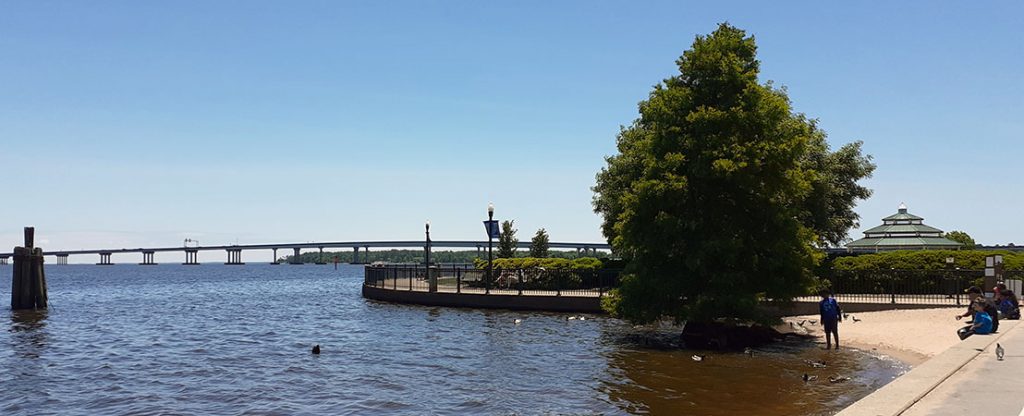In the late 1970s, the redevelopment and integration of the area along the Trent River and Neuse River into the core downtown area focused on creating amenities that would enhance downtown as a destination. Union Point’s prominent location at the confluence of the two rivers and its close proximity to downtown made it a keystone in the redevelopment of the waterfront.
Historically, Union Point served as the site for commercial sawmill operations, seafood processing and naval stores and in the early 20th century as a government dock. New Bern’s decline as a port city led to the gradual deterioration of the Neuse and Trent waterfront, and by the 1920s Union Point degenerated into a city dump.
In 1931, when a development project to construct a multi-story hotel failed, the New Bern Women’s Club initiated clean-up of the area to convert it into a public park and construct a Club House. The Board of Aldermen approved the project “provided it could be done without any cost to the city other than City labor, when it could be spared.”
With President Roosevelt’s announcement municipalities could borrow W.P.A. funds with a local match of funds, the Women’s Club Committee requested some of the relief-employed labor be diverted to the park project.
When the building was completed, Mayor Tolson’s donated a lily pool. The building and park became a rallying point boosting the morale of the city and the place community activities took place for many years.
In the 1950s, Cedric Boyd, Public Works Director, developed the park further with a picnic area, boat ramps, a pavilion, and restrooms. Over the years it continued to be a highly used park.
By the mid-1970s, hurricanes, frequent flooding, and deferred maintenance led to its deterioration. The restrooms were frequently vandalized. The piling and pier decking were decaying. Stress cracks in the exterior walls of the Women’s Club along with the sinking and heaving of the concrete slab floor lead to the building’s closure in the early 1980s.
Adjacent to Union Point, the three-acre abandoned Texaco site, surrounded by a chain link fence, housed seven fuel tanks, a vacant service station and warehouse with a large expanse of asphalt paving.
In the early 1980s, with waterfront redevelopment a major objective in the downtown revitalization effort, the City and Swiss Bear agreed acquisition of the Texaco land would provide the opportunity to expand Union Point Park.
In September 1982, learning Texaco was exploring having the tanks removed from the site, Tony Hooper, City Manager, contacted Jim Nay, Texaco’s Division Manager, Bellaire, TX, inquiring if the company would consider donating the property to the city for use as a public park. Although Jim Nay responded the tract (appraised at $300,000) was too valuable to give away, correspondence continued.
In late October, when Texaco agreed to donate the waterfront section to the City and subdivide and sell the front two parcels for a bargain sale of $10,000, Swiss Bear’s Board made Texaco an offer of $10,000 for the two lots. After months of negotiation, on June 15, 1983, Jim Nay, Division Manager, presented deeds to Swiss Bear Chairman Harold Talton and Mayor Paul Cox at a Press Conference in Bear Plaza.
In July 1983, the Board of Aldermen granted Swiss Bear the authority to develop a plan for the highest and best use of the Texaco property and Union Point and flexibility in negotiations with the City on disposition of the Texaco property owned by Swiss Bear.
An East Waterfront Task Force, appointed by the Board of Aldermen and chaired by John Ward, included representatives from the City, County, Swiss Bear, Chamber of Commerce, Weyerhaeuser, Hatteras Yachts, Neuse River Foundation, and was later expanded with sub-committees from the business community for fund-raising, project design, and grants to cover costs incurred.
After visiting numerous waterfront cities and meeting weekly, Task Force members concluded the best use was development of a visitor and river resource center dedicated to the identification, study, and resolution of water-quality problems adversely affecting residential and industrial development.
In April 1984, they held a Design Competition for the design and layout of the 6.5 acre site. Seventeen architect and landscape architect firms submitted entry drawings. The award-winning design by Edgar Carr & Associates called for the excavation of most of Union Point to create a protected harbor with a barrier island, a resource center, waterfront promenade, amphitheater for outdoor performances, and boat docks.
The Kellenberger Historical Foundation approved a $5,000 grant for the design phase and the Board of Aldermen approved $9,000 for a feasibility study. Commitments to fund the $3-4 million project received financial support from several local major industries.
In 1986, Swiss Bear sold its two Texaco parcels to the City for $14,500, covering costs incurred to demolish the two buildings and clean up site debris.
Over the next three years, the project remained controversial in spite of numerous public meetings and modifications to the design. Residents voiced anger at losing the use of the park and fishermen the loss of the boat ramps. To address that issue, Swiss Bear took the lead and paid $2,000 for a plan to upgrade Lawson Creek Park (also a dump site in previous years), the City appropriated $27,000, and the County provided the labor to build four new boat-launching ramps.
In December 1987, failing to gain state support for a major appropriation to help fund the project, Task Force members, the Swiss Bear Executive Board, and Board of Aldermen determined the Union Point Task Force should work with Edgar D. Stone and Associates (EDSA), design competition third-place winner, to come up with a plan for Union Point.
However, other waterfront controversies arose that laid the groundwork for development of the 1990 Urban Design Plan which, in addition to providing a clear vision for all of downtown, would include a new design concept for Union Point Park.
The design concept for the park, as presented in the 1990 urban design plan, is what was accepted by the community and was used to guide the redevelopment of the park in the mid-1990s, to include incorporating the Texaco property for parking, public bathrooms, and additional green space.
By Susan Moffat-Thomas, retired Executive Director, Swiss Bear Downtown Development Corporation



